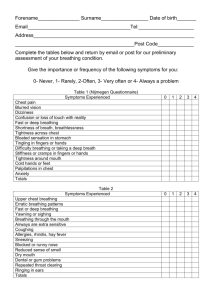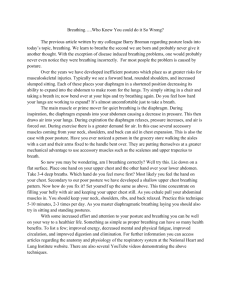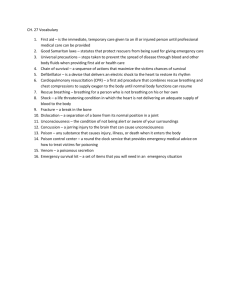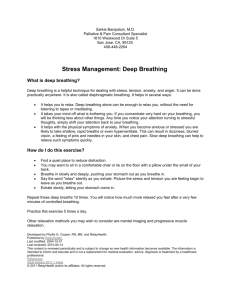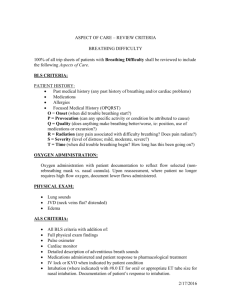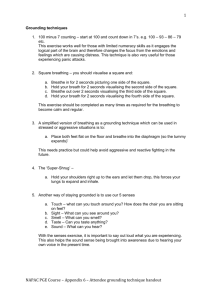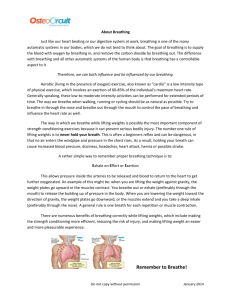Essential Health
advertisement
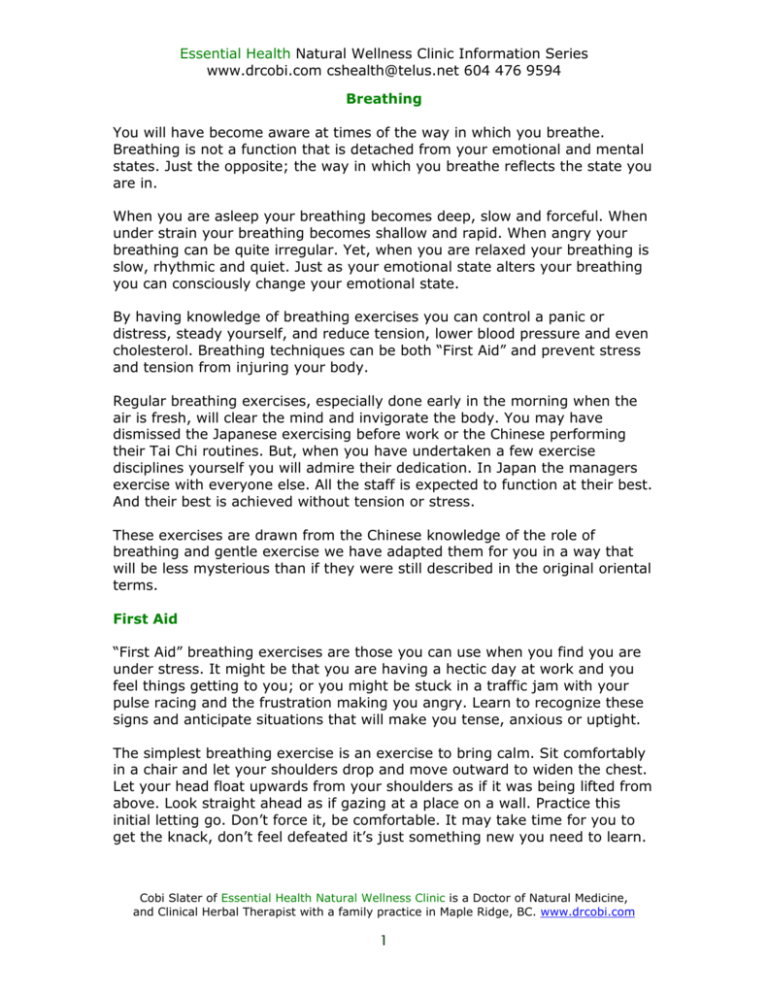
Essential Health Natural Wellness Clinic Information Series www.drcobi.com cshealth@telus.net 604 476 9594 Breathing You will have become aware at times of the way in which you breathe. Breathing is not a function that is detached from your emotional and mental states. Just the opposite; the way in which you breathe reflects the state you are in. When you are asleep your breathing becomes deep, slow and forceful. When under strain your breathing becomes shallow and rapid. When angry your breathing can be quite irregular. Yet, when you are relaxed your breathing is slow, rhythmic and quiet. Just as your emotional state alters your breathing you can consciously change your emotional state. By having knowledge of breathing exercises you can control a panic or distress, steady yourself, and reduce tension, lower blood pressure and even cholesterol. Breathing techniques can be both “First Aid” and prevent stress and tension from injuring your body. Regular breathing exercises, especially done early in the morning when the air is fresh, will clear the mind and invigorate the body. You may have dismissed the Japanese exercising before work or the Chinese performing their Tai Chi routines. But, when you have undertaken a few exercise disciplines yourself you will admire their dedication. In Japan the managers exercise with everyone else. All the staff is expected to function at their best. And their best is achieved without tension or stress. These exercises are drawn from the Chinese knowledge of the role of breathing and gentle exercise we have adapted them for you in a way that will be less mysterious than if they were still described in the original oriental terms. First Aid “First Aid” breathing exercises are those you can use when you find you are under stress. It might be that you are having a hectic day at work and you feel things getting to you; or you might be stuck in a traffic jam with your pulse racing and the frustration making you angry. Learn to recognize these signs and anticipate situations that will make you tense, anxious or uptight. The simplest breathing exercise is an exercise to bring calm. Sit comfortably in a chair and let your shoulders drop and move outward to widen the chest. Let your head float upwards from your shoulders as if it was being lifted from above. Look straight ahead as if gazing at a place on a wall. Practice this initial letting go. Don’t force it, be comfortable. It may take time for you to get the knack, don’t feel defeated it’s just something new you need to learn. Cobi Slater of Essential Health Natural Wellness Clinic is a Doctor of Natural Medicine, and Clinical Herbal Therapist with a family practice in Maple Ridge, BC. www.drcobi.com 1 Essential Health Natural Wellness Clinic Information Series www.drcobi.com cshealth@telus.net 604 476 9594 When you can do this easily your lungs will be free to fill from top to bottom so take a few deep, slow but gentle breaths. You are now ready to start the calming breathing. Breathe in freely to the count of three and out again also to the count of three. Let the chest expand and deflate as you breathe. Try not to exaggerate the movements. This is a way of controlling your stress response, quieting the nervous system and gets you back in balance. Once you have got the knack of this you can do it anywhere and when you need it. So simple and so effective. Breathing Exercises to Help You Sleep This is a help for those whose minds won’t switch off from the events of the day. Go to bed and make yourself ready for sleep. Close your eyes and make yourself comfortable. Breathe deeply and gently letting the stomach expand and contract, deepening the breathing. Try to visualize your breath as you exhale moving up from the diaphragm through the lungs and out of the mouth. In your minds eye watch the air follow an arc like a rainbow from your mouth back to your tummy and through the imaginary hole back to the diaphragm. Then start again with a slow rhythm, breathing and seeing the breath flow through the lungs and over the chest to the mouth counting 1-23-4 then blow it back to the diaphragm with another 1-2-3-4 keep visualizing the circle of air as it moves through you and round to the diaphragm keep your mind fully involved with this process and you will find sleep gently enfolds you. Breathing Exercises to Reduce Tension When you feel strain and tension in your neck and shoulders there is a simple exercise that you can do to reduce the stiffness and pain. You may find that you need to do this exercise several times a day when you’re under pressure or feel tense. That’s ok, better to dispense the feeling than to let it build up. Stand up, stretch your arms above your head then let them fall loosely to your sides. Straighten your back, hold in your stomach, and tuck your bottom under, let your head rise and your shoulders drop. This will encourage the blood flow. Take a slow breath in and count 1-2-3-4. Hold it in 1-2-3-4 then breath out 1-2-3-4 at the same time allow your shoulders to drop further, now make a circle with your head, let it drop onto your chest, roll the head over the left shoulder, let it drop behind you and roll over the right shoulder and back onto the chest. Roll the head three times to the left then three times to the right breathing easily all the time. Finally lift the head, take a deep steady breath and you will feel less tired and tense. Cobi Slater of Essential Health Natural Wellness Clinic is a Doctor of Natural Medicine, and Clinical Herbal Therapist with a family practice in Maple Ridge, BC. www.drcobi.com 2


